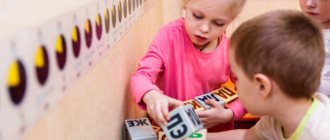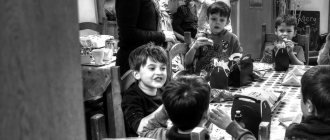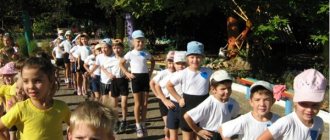Diet in kindergarten
Meals in kindergartens are designed taking into account the age characteristics of the child. The norm for nursery groups is 155 kcal, for older children - 1900 kcal per day. Nutrition standards for preschool institutions were developed by the Institute of Nutrition of the Russian Academy of Medical Sciences.
The menu is designed in such a way that dishes are not repeated within 20 days. Agree, such a varied diet at home is rare, especially for working mothers.
Products are supplied by supplier companies that undergo a competition. The company that wins the tender enters into a contract with the preschool educational institution.
Thus, the supplier brings fresh products to the kindergarten, and there the cook prepares the food on site. Moreover, dishes must be prepared immediately before consumption: food that has stood for more than 2 hours is already considered stale.
Your daily diet should include:
- meat;
- milk;
- dairy products;
- bread;
- potato;
- fruits;
- cereals;
- vegetables;
- butter and vegetable oil;
- drinks (juices, cocoa, compotes).
Other products (fish, cottage cheese, eggs, cheese, etc.) - 2 - 3 times a week.
Dishes can be replaced with identical ones. For example, chicken can be replaced with turkey, beef, rabbit meat; fish - seafood, some vegetables can be replaced with others, etc. The main thing is that the number of calories when replacing corresponds to the norm.
For children with allergies, foods that cause food allergies are excluded.
Attention! Children are prohibited from giving food that has not undergone heat treatment, except for salted herring, trout and salmon. Also, their diet should not contain canned food, pickled vegetables, mushrooms, wild animal meat, dairy products with vegetable fats, cream confectionery, carbonated drinks, fried and spicy foods.
Also read on our website: Diet for nursing mothers
Do you want to know who you are for your child - a friend or a teacher? Find out HERE!
Organizing meals in kindergarten: methods and nuances. consultation
Organizing meals in kindergarten: methods and nuances.
Nutrition culture in kindergarten is a science necessary in modern life. Fast food, which looks attractive in conditions of eternal lack of time, strives to displace healthy food from our diet. This is not at all beneficial for a growing child's body. Since children spend most of the day in kindergarten, it is the educators who are responsible for teaching the child how to eat healthy, tasty, beautifully and, most importantly, carefully.
Etiquette lessons begin at an early age. The child learns not only to behave properly at the table, but also to confidently use cutlery, be neat and polite.
Table setting rules
In kindergarten, children are taught to eat in the classic, European manner: fork in the left hand, knife in the right. Based on this, tables are set. Forks are given to children starting from the younger group, and knives - from the older group.
It is advisable for each group to have its own dishes, the colors of which may correspond to the name of the group (“Daisies”, “Kids”). When moving to the senior group, the set of dishes changes.
In the older group, an additional item may appear on the tables - a salt shaker with a small spoon. Often children, not wanting to eat a low-salt dish, refuse to eat. But it is enough to allow them to add a little salt to the dish, and the appetite immediately appears. Of course, children need to be told that excess salt is extremely harmful and that moderation must be observed.
Depending on the meal time, tables are set differently.
For breakfast, a vase of flowers, a bread box, a plate with portioned butter, a napkin holder, and saucers are placed in the middle of the table. Forks are laid out on the left side, knives on the right, spoons parallel to the edge of the table. To keep it warm, the main course is served only when the child sits down at the table. Dishes are removed to the left of the sitting child.
For lunch, the table is set in a similar way, but juice and compote are poured into cups on the table in advance, and plates are placed in a pile on the edge of the table. At the same time, in the younger groups only deep plates are placed, and in the middle and older groups - deep and small plates in cases where the second dish is laid out in the group and not brought from the kitchen. Used dishes are immediately removed.
Some kindergartens encourage children's habits that may not always be considered healthy. For example, many children who do not like boiled onions, carrots or cabbage put them on a plate prepared in advance by the nanny. However, educators must work with students, trying to teach them to eat all the thick liquid along with the liquid. As a last resort, you can put a piece of onion on the edge of your plate.
For afternoon tea, the table is set as for breakfast - with the only difference: butter is not served.
Formation of cultural and hygienic skills at the table
As a child grows, his table manners improve. Go to the nursery and senior groups, and you will not only see, but also hear the difference. The kids sit as if due to their age and restlessness, crumbs are scattered, trying to chat - not everywhere, of course, but this is a typical picture. And take the older group: the children sit and eat quietly, no one chats or laughs. After eating, they wipe themselves with a napkin, thank the nanny and help the attendant clean up the dishes.
Young children (1-2 years old) are taught:
- wash your hands before eating and dry them with a towel (with the help of an adult);
- sit down at a chair;
- use a cup: hold it in such a way that the liquid does not spill, drink slowly;
- use a spoon;
- wipe yourself with a napkin after eating;
- eat thick food with a spoon or with bread;
- After finishing the meal, leave the table and push in your chair.
Children of the first junior group (2-3 years old) are taught:
- Wash your hands yourself before eating, wipe them dry with a towel;
- eat neatly, holding a spoon in your right hand;
- wipe yourself with a napkin after eating;
- give thanks after eating.
Children of the second younger group (3-4 years old) are taught:
- wash your hands independently and carefully with soap, dry yourself with a towel, hang the towel in its place;
- use cutlery correctly;
- eat carefully: do not crumble the bread, chew food with your mouth closed.
Children of the middle and senior groups (4-5 years old, 5-6 years old) are taught:
- take food in small portions;
- eat quietly;
- use cutlery (fork, spoon, knife) correctly;
- sit with a straight back;
- neatly arrange dishes after meals;
- take some of the dishes with you.
Children of the school preparatory group (6-7 years old) consolidate the acquired skills of table manners: do not put their elbows, sit up straight, chew their food thoroughly, and use cutlery correctly.
Forms of instilling a food culture
The forms of instilling a culture of nutrition in kindergarten are varied. One of them is duty. Desk attendants are given an elegant uniform consisting of colored caps and aprons. All these clothes are stored in the Duty Officer's Corner.
Children begin to be on duty from the second junior group, at the end of the school year. The attendant helps the nanny set the table, at which he eats. The preschooler arranges glasses, puts napkins, spoons, and puts out bread bins.
In the middle group, children consolidate table setting skills. In the second half of the year, responsibilities increase: arrange the saucers that the nanny had previously placed on the table, put napkins in glasses, remove bread bins and glasses with napkins after meals.
In the senior and preparatory groups, those on duty can independently set the table and clean up after meals. The responsibilities of the attendants include not only arranging dishes, but also, for example, folding cloth napkins. This activity greatly contributes to the development of fine motor skills of the hand.
The people on duty take the announcement of the menu seriously, a kind of mini-actor's skit. After all, the menu can be read out with expression so that children who have not yet experienced hunger will want to try all the dishes.
Celebrations are organized in preschool institutions. Food Culture Day is especially popular. As part of it, various master classes are held on preparing salads, decorating dishes, and conversations are held about culinary preferences and traditions that have come to us from other countries.
As you know, appetite largely depends on how “tasty” the food looks and how beautifully the table is set. In this regard, kindergartens often announce competitions for the best table setting.
Nutrition plays a big role in the process of growth and development of a child and is of great importance for his health. Insufficient provision of iron, selenium, iodine, zinc, calcium, etc. to young children can serve as the basis for significant impairments in the formation of intelligence, the musculoskeletal system or connective tissue in general, the reproductive sphere, decreased physical performance, etc. Therefore, , rational and nutritious nutrition of preschoolers is the key to good health, normal growth and proper development of children.
Nutrition is an essential component of the daily routine. The entire process associated with feeding children is of great educational importance. Children are taught the important hygiene skills of washing their hands before eating, rinsing their mouths after eating, and using cutlery and napkins; They are taught to chew food thoroughly, eat carefully and sit correctly at the table.
When carrying out the feeding process, everything that is included in the concept of “nutritional aesthetics” is of great importance.
During their stay in a preschool institution, the child learns to behave properly at the table, use utensils (spoon, knife, fork), and acquires certain food culture skills.
Issues of nutritional aesthetics should be given attention, starting with groups of young children. The earlier a child develops correct eating habits, the more firmly they will become established and become a habit.
It is important that your baby develops a positive attitude towards eating so that he is not irritated or tired by the time he feeds. To do this, educators must take care to create a calm environment in the group. Before eating, you should avoid noisy games and strong impressions, which can inhibit the production of digestive juices in children and suppress the food reflex.
20-30 minutes before the next meal, children are returned from a walk or activities and games are stopped. This time is used to create a certain mood in children that is conducive to eating.
Before eating, children put their clothes in order, wash their hands thoroughly, and the attendants take whatever part they can in setting the table. Each child has a permanent place at the table.
During feeding, it is important to create a good mood in children. To do this, the preschool institution must have beautiful, comfortable, stable dishes and cutlery that are appropriate in size for the age of the children. The tables are covered with tablecloths or napkins, and vases of flowers are placed. The dishes are served beautifully presented, not very hot, but not cold either. To decorate dishes, it is advisable to use fresh herbs, brightly colored vegetables, and fruits.
During the feeding process, the teacher should not rush the children or distract them with extraneous conversations or comments. During feeding, children are told about the pleasant appearance, taste, smell of food, its usefulness, and they try to focus each child’s attention on food. It is necessary to monitor the behavior of children at the table, maintain cleanliness and tidiness, teach them to chew food well, not swallow it in large pieces, and eat everything that is offered.
Compliance by children with hygiene requirements is one of the responsibilities of the teacher during the feeding process. This is especially important in groups of young children, when children are actively developing and consolidating skills and habits. Young children are taught to sit quietly at the table, skillfully use a napkin, chew with their mouth closed, and not talk while eating. Children learn to use cutlery: from 1.5 to 2 years old they eat with a spoon on their own, from 3 years old they use a fork. In preschool groups, children are given a full cutlery set (knives should not be sharp). Children in the senior and pre-school groups should be able to use a knife and fork correctly, holding it in both their right and left hands.
After finishing the meal, the children carefully blot their mouths with a napkin and wipe their hands, thank them for the food and leave the table. Children should not be allowed to leave the table with a piece of bread or other food, including fruits or berries, cookies or candy.
When feeding children, especially young children, it is necessary to follow the sequence of processes and not force preschoolers to sit at the table for a long time waiting for the meal to start or a change of dishes. The next dish is served immediately after the previous one is eaten. Children who finish eating before others can be allowed to leave the table and engage in quiet play while standing at the table (for example, a builder).
Educators pay great attention to children with decreased appetite. When feeding such children, it is especially important to follow the recommended age-specific portion sizes and take into account individual tastes and habits. Too much food can only discourage the child from eating and lead to an even greater decrease in appetite.
During the adaptation period, many children also eat poorly. Here it is important to correctly explain to parents that the child did not eat everything or ate very little, and we did not force him, because... next time he won’t want to go to the evil aunt’s garden and therefore we ask that we feed him better at home
For younger children, portioned dishes (cutlets, cheesecakes) are placed whole on a plate and, in front of the child, they are divided into smaller pieces with a spoon.
You should not force feed your baby, entertain him while eating with toys, pictures, tell fairy tales, etc. When a child's attention is distracted, the production of digestive juices is inhibited and the food reflex is suppressed. You can accompany your meals with quiet, calm music.
Children with poor appetite can be offered small amounts of water or fruit juice at mealtimes to help them wash down a solid meal. In some cases, you can offer your child a second course first so that he can eat the more nutritious part of the meal before he loses interest in eating.
When feeding a child with poor appetite, his tastes and habits are taken into account: you should try to give your favorite dish, ordering it from the kitchen if necessary. Such a child is patiently introduced to other healthy foods. Sometimes it is allowed to mix the most nutritious dish the child needs (meat, egg, cottage cheese) with fruit puree, juice or another product that the child likes. Older children are explained in an accessible form the need to first eat this or that dish or part of it, and the child is praised if he has eaten everything without a trace.
For this purpose, the following rules must be observed:
- everything necessary for organizing meals (arranging tables in the prescribed order, setting them correctly for children of each age, etc.) should be prepared by the time the children begin to wash their hands.
- washing and sitting down at the table should be done gradually, starting with younger children and those who eat slowly.
- Do not keep children after finishing the meal.
- Prepare food for younger children in advance (cut meat, pancakes, etc.).
- the procedure for serving children, the requirements of the teacher and junior teacher must be uniform and constant.
Thus, systematic, purposeful management of children’s nutrition makes it possible to train them in many good deeds, instill stable hygienic skills, expand their everyday orientation, and solve the problems of moral education.
Diet in kindergarten
In accordance with SanPiN, meals for children are organized in a group at least 4 times (breakfast, second breakfast, lunch, afternoon snack). Some gardens also offer dinner.
The interval between meals is no more than 4 hours.
Optimal meal times in kindergarten:
- 8.30 - 9.00 - breakfast;
- 10.30 - 11.00 - second breakfast;
- 12.00 - 13.00 - lunch;
- 15.30 - 16.00 - afternoon tea;
- 17.00 - 17.30 - dinner.
Meal times fit organically into the general daily routine in kindergarten.
Every day the group posts a menu indicating the name of the dish and serving size, as well as substitutions for children with allergies and diabetes.
What products are allowed in children's diets?
Below is a table of replacement products that can be used in the nutrition of children's educational institutions.
| Baby food requirements | Products not approved for consumption by children |
| · Meat and fish; | · Meat of wild animals; |
| · Omelette, or boiled chicken eggs; | · Products that have not undergone heat treatment; |
| · Milk products; | · Canned; |
| · Food products that contain vegetable fats; | · Unpasteurized dairy products; |
| · Confectionery; | · Confectionery products containing cream; |
| · Vegetables and fruits; | · Natural coffe; |
| · Canned food; | · Soda. |
| · Juices and drinks; | |
| · Bakery products; | |
| · Salt. |
Until the main menu is approved, compiled on the basis of culinary techniques and recipes that are designed specifically for the standards of children in preschool institutions.
If the child has not reached one year and is artificially fed, it is allowed to receive liquid or dry milk formula.
The names of the dishes must fully correspond to those indicated in the recipes.
The manager of the kindergarten is obliged to notify parents of the list of food products for each day that are served at meals.
Notification is made by providing the menu for the current day in children's groups at stands.
This document must be approved by the manager and contain the following:
- Name of the dish;
- Portion volume;
- List of food products that are replaced for children with allergies and other pathologies.
Sample kindergarten menu
The menu should include soups, cereals, baked goods, dairy and fermented milk products, main hot courses (meat or fish + side dishes), fruits and drinks.
In addition to the regular menu, which you can see in the group, a menu is compiled daily - a layout. This is a regulatory document that calculates the quantity of each product consumed, the number and weight of output portions. Menu - the layout is signed by the medical worker, cook and director.
Do you want to know the microclimate of your family? Take the TEST ON OUR WEBSITE and find out if anything needs to be changed






